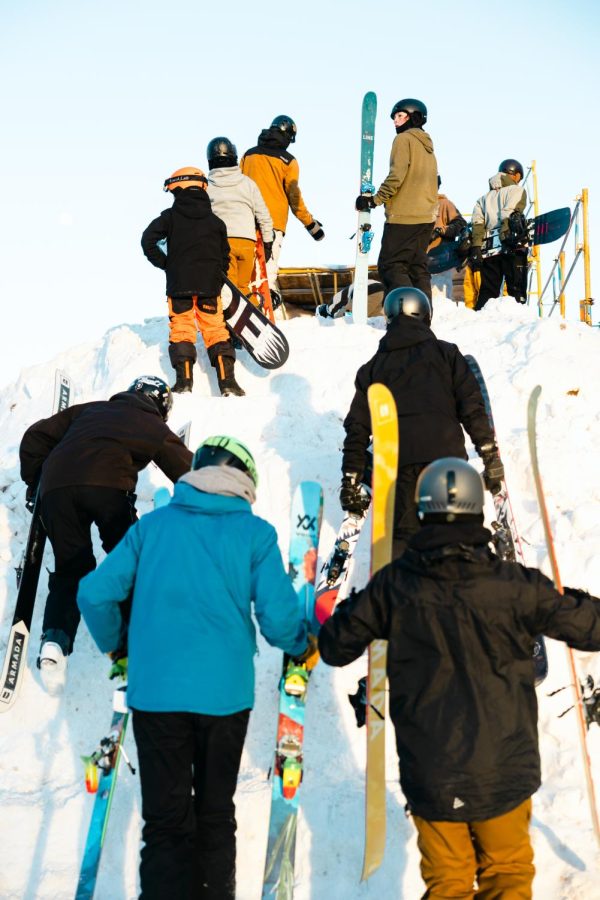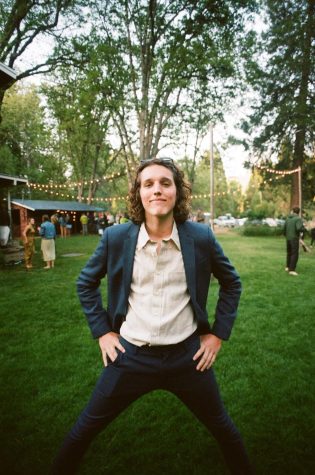Opinion — Time spent with the snow god
A weekend of celebrating at the Heikki Lunta Winter Festival in Negaunee, Michigan.
COWABUNGA — Riders line up before the Irontown Rail Jam on the first night of festivities.
February 22, 2023
Legend speaks of a god that lives deep in the frozen woods of Tapiola, Michigan, a remote village in the far reaches of the Upper Peninsula. Its name is Heikki Lunta. It is said there’s a magical song and dance that, when performed, cause the god to bring down great showers of snow.
Behind this god, there is a creator — and his name is David Riutta.
Riutta was a radio salesman who, in 1970, came up with Heikki Lunta (a name he got by translating Hank Snow into Finnish) to increase support for a snowmobile race that was in danger of being canceled due to lack of snow. He even wrote a song about Heikki. It caught on, and the fabled snow god now has a festival held each year in its honor, and people come together to snowshoe, luge, ski and otherwise celebrate the season.
The Heikki Lunta Winter Festival is held in Negaunee, a city of just under 5,000 residents in Michigan’s Upper Peninsula, and it takes place over two days in late January or early February — usually in the coldest time of winter. The event includes a rail jam, lantern-lit snowshoe tours and an ice fishing competition and is attended by hundreds each year.
Riutta’s song, the “Heikki Lunta Snow Dance Song,” is still played by people hoping for more snow, and this year the dance was performed on live television in anticipation of the event. Riutta’s story stuck, and what began as a bit of a lark has become part of local lore and tradition and passed into myth.
–
Negaunee, Michigan is what you might picture when you think of a small town.
Its downtown is full of old brick buildings, some of which were erected back when it was a mining town in the late 1800s. Some are vacant, and more than a couple have been converted into thrift stores and antique shops. But there’s a spirit of resilience and growth there. The population rose slightly between 2010 and 2020, reversing a decades-long trend.
More than three-quarters of incorporated places in the US have 5,000 or fewer inhabitants, yet they’ve been in decline for the past century. Since the 1800s, there’s been a mass exodus to cities from more rural areas (although in the past few years, people are leaving big cities in droves). Negaunee itself is an example — its population peaked around 9,000 in 1910 and has been steadily going down until just recently.
The decline of small-town America has been lamented by authors, politicians (notably conservatives) and I’d wager many a wistful septuagenarian reflecting on their past (heck, even at 22 I’ve begun saying “back in my day…” with no trace of irony).
People like Wendell Berry have written powerfully on this topic while lamenting the loss of community support, family values and investment in local culture and economy.
The ideal of small-town America has become its own sort of myth.
It’s often used as a political weapon. Politicians from both sides of the aisle say they want to rebuild them, but conservatives often call for a return to old ways and values and suggest that things were better back then when families stayed together and cared for each other, and you knew all of your neighbors and could go next door to borrow some sugar or a few eggs. This sentiment has, in part, helped to fuel campaigns like “Make America Great Again” and coin phrases like ‘rural rage.’
Perhaps a myth like this can be dangerous. But Negaunee doesn’t seem mired in this conversation. Life goes on as usual.
I went there for the festival to see what it meant to celebrate winter. And I saw people coming together. Families were out sledding, luging, drinking hot cocoa and doing other things you might find in a Norman Rockwell painting. Despite the frigid cold — it was 1 degree Fahrenheit on the opening night of festivities — people still showed up bundled from head to toe in snow gear.
So maybe the myth has some truth to it.
I went to Heikki Lunta and in all of those people braving the elements, chatting with me in coffee shops and cheering along while skiers performed sick aerials, I may have even seen the snow god himself.
–
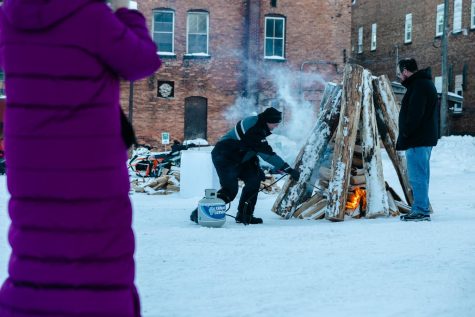
Lighting the bonfire reminded me of my uncle trying to start a fire at a family gathering. Some city official — maybe the mayor? — had a blow torch hooked up to a propane tank, and still, the fire took a few minutes to catch. A few people were gathered around the wooden pyre, including somebody from TV6, a few casual onlookers and a firefighter in case things went south. When the wood finally did ignite, the man threw his hands up in the air and shouted, “Welcome to Heikki Lunta!” A few people clapped and the festival began.
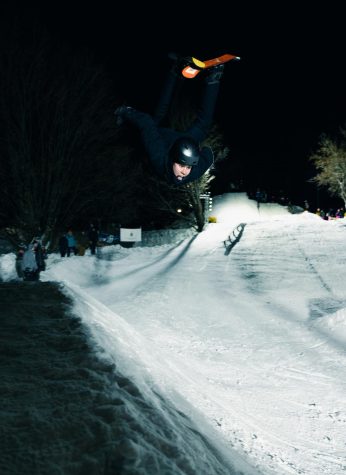
There’s something totally committing about throwing a trick on skis or a snowboard. My favorite moment to watch is the second a rider leaves the takeoff, when they twist or rotate their body and give themselves up to whatever happens next.
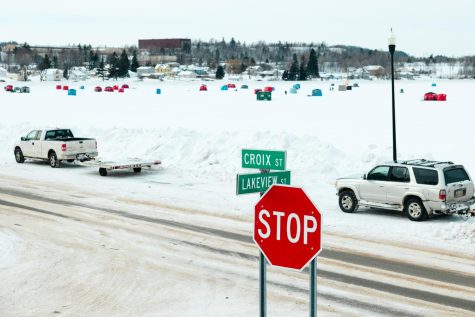
I wish I had x-ray vision so I could see everyone inside of their little huts, huddled over a hole in the ice waiting for their rod to move. As things were, all I could see were the mostly red and blue tents resting atop the icy tundra. It was eerily quiet when I stepped out on the frozen lake. An occasional group would walk over to check a hole, or a kid’s head would pop out of a tent, and he’d go running across the ice, but mostly I only heard the sound of the wind and passing cars on the highway. Many of them had been out there since 6 a.m., trying to pick the right part of the lake to dangle bait for a walleye.
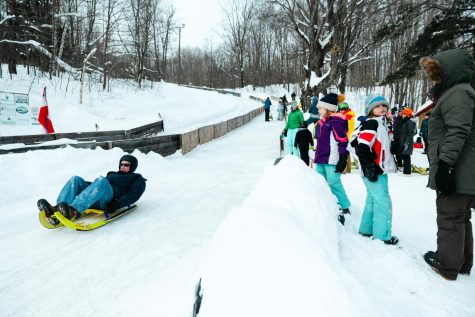
They only allowed lugers to slide down maybe 50 yards of track, but that didn’t stop people from grinning big or clenching their teeth in fear on the way down. It reminded me of sledding when I was young at the local hill, back when I didn’t have to spend money on a lift ticket to play in the snow.
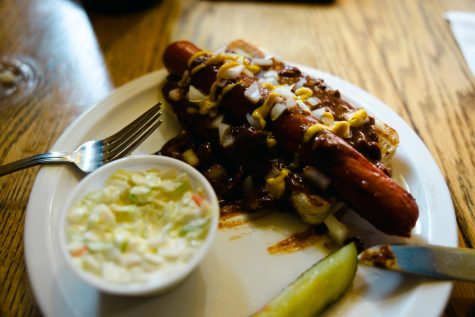
I ducked in for an hour around midday to escape the cold and find some sustenance. The chili dog was good, and the restaurant felt old school, the kind of place I’ll fritter away lots of my time at when I’m old.
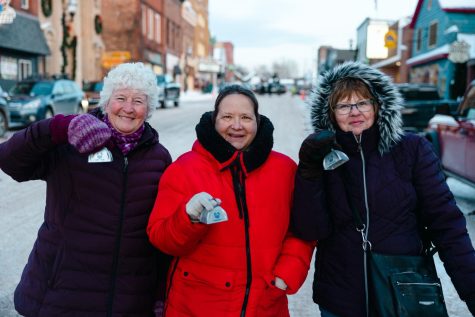
I had a few conversations while waiting for the race to start — one about local history and another about AI and art. The street that day was as good a place as any to hail a stranger and strike up a conversation. Everyone was welcoming, kind and very neighborly.
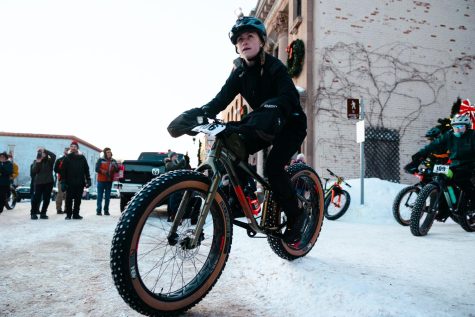
The race began around sunset and ran into the night. Rippers of all ages were out there barreling along the frozen ground.
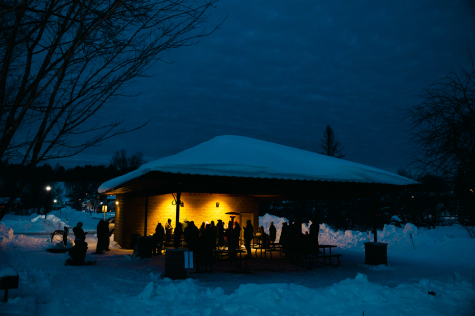
I heard one of my favorite quotes from the day right after I took this photo: “Never had Trenary Toast?! What are you taalkin’ abowt?!”























